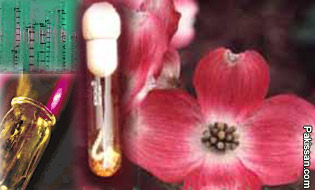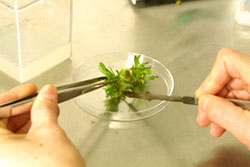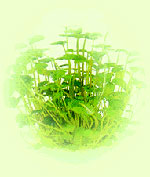Although the idea of plant tissue and cell culture was conceived as early as 1902 by the German botanist Harberlandt, it was only during the last three decades or so that its application have increased considerably both in the basic research especially in the agriculture and horticulture. Now it has emerged as a multi-billion dollars industry for growing ornamentals and other botanicals.
 Starting from Himalaya foot hills to Karachi, Pakistan has a variety of ecological zones and a wide range of vegetation including flowers, foliage plants and crops which offers tremendous scope for exploiting tissueculture techniques for mass multiplication of economically important flora. This can be particularly useful in the production of economically important flora. This can be particularly useful in the production of elite and rare orchids and other plants, which have, export value. However, for effective utilisation of this technique it is necessary that scientists and private sector should interact and work on the practical application of the techniques for commercial purposes.
Starting from Himalaya foot hills to Karachi, Pakistan has a variety of ecological zones and a wide range of vegetation including flowers, foliage plants and crops which offers tremendous scope for exploiting tissueculture techniques for mass multiplication of economically important flora. This can be particularly useful in the production of economically important flora. This can be particularly useful in the production of elite and rare orchids and other plants, which have, export value. However, for effective utilisation of this technique it is necessary that scientists and private sector should interact and work on the practical application of the techniques for commercial purposes.
This has been successfully done in Malaysia, Srilanka and Singapore. Singapore alone is earning 2 million U.S. dollars by exporting of orchids mostly grown through this technique. Unfortunately we have not been able to exploit the tissue culture technique to a considerable extent. Time has now come to get into action to utilize the technology available for the benefit of the nation. There is yet no major commercial utilization of tissue culture in Pakistan. University of Agriculture can play a valuable role in the development of a program for the application of tissueculture in agriculture, horticulture, forestry, medicinal plants and ornamentals.
 Tissue culture technology is an established method of micropropagation of plants including cash crops, flowering shrubs and trees. Today nearly 50 companies in India are engaged in this business. This technology is particularly very useful for afforestation, as many trees take long time to grow and many of the conventional methods of propagation such as through seeds, cuttings and grafting are often slow and difficult.
Tissue culture technology is an established method of micropropagation of plants including cash crops, flowering shrubs and trees. Today nearly 50 companies in India are engaged in this business. This technology is particularly very useful for afforestation, as many trees take long time to grow and many of the conventional methods of propagation such as through seeds, cuttings and grafting are often slow and difficult.
Tissue culture is also useful for initial building-up of propagating stock of elite clones/individuals. It has found its best commercial application in propagation of clonal plants at very rapid rate compared to conventional methods. In certain cases it has been increased to million fold. Thus, it may immensely help in introducing newly created cultivars in trade. Presently, some 300 plant species have been demonstrated to be clonally propagatable through tissue culture (Murashige, 1978,1980; Vasil and Vasil, 1980; Flick et al., 1983). of the various plant species generally the ornamentals have been most successfully multiplied through tissue culture technique on commercial. The most glaring example is of orchid, the trade of which has been revolutionized by tissue culture (Hartmann and Kester, 1975; Morel, 1975; Rao, 1977).
History of Tissue Culture in Pakistan:
Hardly ten years ago the term plant tissue culture was totally new to most of universities and research organizations in Pakistan. There were, however, sporadic reports from Department of Genetics, University of Karachi, C.C.R.I., Multan and Department of Botany University of Peshawar. From 1980 on ward there was a quantum leap in the number of tissue culture lab. in various parts of Pakistan although main activity in this field is conducted in public sector laboratories, we have now reached to a stage when the private sector is seemingly willing to invest in this new technology. Undoubtedly It has been emerged as a rapidly developing science because of its proven success on agriculture: in propagation, elimination of diseases, establishment of new varieties in a reduced span of time, shortened breeding cycle and conservation and propagation of endangered and threatened plant species.
universities and research organizations in Pakistan. There were, however, sporadic reports from Department of Genetics, University of Karachi, C.C.R.I., Multan and Department of Botany University of Peshawar. From 1980 on ward there was a quantum leap in the number of tissue culture lab. in various parts of Pakistan although main activity in this field is conducted in public sector laboratories, we have now reached to a stage when the private sector is seemingly willing to invest in this new technology. Undoubtedly It has been emerged as a rapidly developing science because of its proven success on agriculture: in propagation, elimination of diseases, establishment of new varieties in a reduced span of time, shortened breeding cycle and conservation and propagation of endangered and threatened plant species.
Ability to establish and maintain plant organs (embryos, shoots, roots, flowers) and plant tissues (cells, callus, and protoplasts) in aseptic culture and to regenerate new plants from them is a result of basic and applied research in scientific laboratories (botany, plant pathology and genetics) since before the turn of the century. These separate procedures have been collectively called tissue and organ culture, in vitro culture, micropropagation, and most recently biotechnology. The commercial application of tissue culture was first discovered in the sixties in the west and since then it has become a multi-billion dollar industry for growing ornamental.
In coconut the biggest problem is the coconut root (wilt) disease and mycoplasm like organisms are involved. Tissue culture can come in handy to produce disease free planting material, which we require for large scale replanting.
Majority of commercial potato cultivar in uses e.g. Ultimus, Desiree, Malta, Cardinal and Diamont, are being imported every year in the form of virus free seed. The same seed could be prepared in this country by tissue culture techniques. (One example is the discovery of anther culture for haploid production which has become a potent tool for the plant breeder as well as for cell biologist. DR. Iqrar Ahmad Khan, Associate Professor, Department of Horticulture, University of Agriculture, Faisalabad). Plant tissue culture refers to in vitro and aseptic cultivation of plant part (cell or tissue) on a nutrient medium in an artificial environment.
 Starting from Himalaya foot hills to Karachi, Pakistan has a variety of ecological zones and a wide range of vegetation including flowers, foliage plants and crops which offers tremendous scope for exploiting tissueculture techniques for mass multiplication of economically important flora. This can be particularly useful in the production of economically important flora. This can be particularly useful in the production of elite and rare orchids and other plants, which have, export value. However, for effective utilisation of this technique it is necessary that scientists and private sector should interact and work on the practical application of the techniques for commercial purposes.
Starting from Himalaya foot hills to Karachi, Pakistan has a variety of ecological zones and a wide range of vegetation including flowers, foliage plants and crops which offers tremendous scope for exploiting tissueculture techniques for mass multiplication of economically important flora. This can be particularly useful in the production of economically important flora. This can be particularly useful in the production of elite and rare orchids and other plants, which have, export value. However, for effective utilisation of this technique it is necessary that scientists and private sector should interact and work on the practical application of the techniques for commercial purposes.This has been successfully done in Malaysia, Srilanka and Singapore. Singapore alone is earning 2 million U.S. dollars by exporting of orchids mostly grown through this technique. Unfortunately we have not been able to exploit the tissue culture technique to a considerable extent. Time has now come to get into action to utilize the technology available for the benefit of the nation. There is yet no major commercial utilization of tissue culture in Pakistan. University of Agriculture can play a valuable role in the development of a program for the application of tissueculture in agriculture, horticulture, forestry, medicinal plants and ornamentals.
 Tissue culture technology is an established method of micropropagation of plants including cash crops, flowering shrubs and trees. Today nearly 50 companies in India are engaged in this business. This technology is particularly very useful for afforestation, as many trees take long time to grow and many of the conventional methods of propagation such as through seeds, cuttings and grafting are often slow and difficult.
Tissue culture technology is an established method of micropropagation of plants including cash crops, flowering shrubs and trees. Today nearly 50 companies in India are engaged in this business. This technology is particularly very useful for afforestation, as many trees take long time to grow and many of the conventional methods of propagation such as through seeds, cuttings and grafting are often slow and difficult.Tissue culture is also useful for initial building-up of propagating stock of elite clones/individuals. It has found its best commercial application in propagation of clonal plants at very rapid rate compared to conventional methods. In certain cases it has been increased to million fold. Thus, it may immensely help in introducing newly created cultivars in trade. Presently, some 300 plant species have been demonstrated to be clonally propagatable through tissue culture (Murashige, 1978,1980; Vasil and Vasil, 1980; Flick et al., 1983). of the various plant species generally the ornamentals have been most successfully multiplied through tissue culture technique on commercial. The most glaring example is of orchid, the trade of which has been revolutionized by tissue culture (Hartmann and Kester, 1975; Morel, 1975; Rao, 1977).
History of Tissue Culture in Pakistan:
Hardly ten years ago the term plant tissue culture was totally new to most of
 universities and research organizations in Pakistan. There were, however, sporadic reports from Department of Genetics, University of Karachi, C.C.R.I., Multan and Department of Botany University of Peshawar. From 1980 on ward there was a quantum leap in the number of tissue culture lab. in various parts of Pakistan although main activity in this field is conducted in public sector laboratories, we have now reached to a stage when the private sector is seemingly willing to invest in this new technology. Undoubtedly It has been emerged as a rapidly developing science because of its proven success on agriculture: in propagation, elimination of diseases, establishment of new varieties in a reduced span of time, shortened breeding cycle and conservation and propagation of endangered and threatened plant species.
universities and research organizations in Pakistan. There were, however, sporadic reports from Department of Genetics, University of Karachi, C.C.R.I., Multan and Department of Botany University of Peshawar. From 1980 on ward there was a quantum leap in the number of tissue culture lab. in various parts of Pakistan although main activity in this field is conducted in public sector laboratories, we have now reached to a stage when the private sector is seemingly willing to invest in this new technology. Undoubtedly It has been emerged as a rapidly developing science because of its proven success on agriculture: in propagation, elimination of diseases, establishment of new varieties in a reduced span of time, shortened breeding cycle and conservation and propagation of endangered and threatened plant species.Ability to establish and maintain plant organs (embryos, shoots, roots, flowers) and plant tissues (cells, callus, and protoplasts) in aseptic culture and to regenerate new plants from them is a result of basic and applied research in scientific laboratories (botany, plant pathology and genetics) since before the turn of the century. These separate procedures have been collectively called tissue and organ culture, in vitro culture, micropropagation, and most recently biotechnology. The commercial application of tissue culture was first discovered in the sixties in the west and since then it has become a multi-billion dollar industry for growing ornamental.
In coconut the biggest problem is the coconut root (wilt) disease and mycoplasm like organisms are involved. Tissue culture can come in handy to produce disease free planting material, which we require for large scale replanting.
Majority of commercial potato cultivar in uses e.g. Ultimus, Desiree, Malta, Cardinal and Diamont, are being imported every year in the form of virus free seed. The same seed could be prepared in this country by tissue culture techniques. (One example is the discovery of anther culture for haploid production which has become a potent tool for the plant breeder as well as for cell biologist. DR. Iqrar Ahmad Khan, Associate Professor, Department of Horticulture, University of Agriculture, Faisalabad). Plant tissue culture refers to in vitro and aseptic cultivation of plant part (cell or tissue) on a nutrient medium in an artificial environment.
 Unknown
Unknown








0 komentar:
Post a Comment